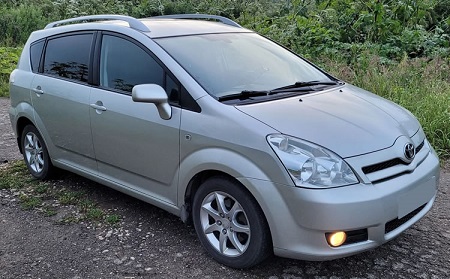|
To learn more about the Toyota Corolla Verso, model AR10, it's worth examining this vehicle's architecture analysis. 
The Toyota Corolla Verso, model code AR10 (produced 2004-2009), represents the third and final generation of Toyota's compact Multi-Purpose Vehicle (MPV) based on the Corolla platform. This article provides a systematic examination of the vehicle's architecture, technical specifications, its position within the competitive landscape, and a foundational overview of its maintenance and repair protocols. The objective is to furnish a consolidated technical reference for this model, highlighting its engineered characteristics and serviceability.
1. Introduction
The AR10 was developed during a period of intense competition in the European compact MPV segment. It was designed to offer the reliability and build quality associated with the Corolla marque within a versatile, space-efficient monospace body. As a vehicle derived from a passenger car platform, its engineering prioritizes ride comfort, packaging efficiency, and predictable handling dynamics over the utility of larger, van-based MPVs. This analysis deconstructs the vehicle's primary systems to elucidate its operational parameters and service lifecycle.
2. Vehicle Architecture and Design Principles
The Corolla Verso 3 is built upon the Toyota MC platform, which it shared with contemporaneous Corolla and Avensis models. This platform choice informed its fundamental engineering layout.
- Body and Chassis: The vehicle features a steel unibody construction with a compact, transverse engine and front-wheel-drive layout (with an optional All-Wheel-Drive system on certain markets). The design incorporates a high roofline and a short, steeply raked hood to maximize interior volume. A key design feature is the standard seven-seat configuration, with a fully foldable third-row seat integrated into the cabin floor.
- Suspension System: The suspension configuration was selected to balance comfort, space, and cost-effectiveness.
- Front: Independent MacPherson struts with a stabilizer bar.
- Rear: A torsion beam axle with integrated stabilizer bar. This space-efficient design maximizes cargo and rear passenger room while providing compliant ride characteristics.
- Safety and Electronics: The vehicle was equipped with a suite of safety features for its time, including multiple airbags, and optional stability control (VSC) and traction control (TRC). Its electronic architecture utilizes a Controller Area Network (CAN bus) to manage communication between various Electronic Control Units (ECUs), necessitating specialized diagnostic tools for advanced troubleshooting.
3. Technical Specifications and Powertrain Configurations
The AR10 was offered with a range of gasoline and diesel engines, tailored primarily for the European market.
- Gasoline Engines:
- The 1.6-liter 1ZZ-FE engine (110 hp) served as the entry-level option.
- The 1.8-liter 1ZZ-FE engine (129 hp) was the volume gasoline unit.
- The 2.0-liter 1AZ-FSE engine (147 hp) featured direct injection for improved power and efficiency.
- Diesel Engines:
- The 2.0-liter 1CD-FTV (116 hp) and 2.2-liter 2AD-FTV (136 hp and 177 hp) D-4D common-rail turbo diesel engines were the most popular choices, renowned for their torque and fuel economy.
- Transmission Systems:
- Standard 6-speed manual transmission.
- A 4-speed automatic and a Multimode (MMT) automated manual transmission were available as options, depending on the engine and market.
4. Competitive Landscape Analysis
Within the C-MPV segment, the Corolla Verso competed against several key rivals, each with distinct engineering philosophies.
- Renault Scénic III: A segment benchmark, offering a highly car-like driving experience, innovative features, and a wide range of efficient engines, though with varying long-term reliability perceptions.
- Volkswagen Touran: Based on the PQ35 platform (Golf V), it was praised for its solid build quality, refined ride, and TDI engine options, often commanding a higher purchase price.
- Opel Zafira B: Noted for its versatile "Flex7" seating system and competitive pricing, though its dynamics and interior materials were often considered less refined.
The Toyota's primary competitive advantages were its renowned reliability, low cost of ownership, and strong residual value, often offsetting its more conservative design and less engaging driving dynamics compared to some European rivals.
5. Maintenance and Repair: Protocol Overview
Adherence to prescribed maintenance intervals is critical for vehicle longevity. The following protocols are derived from official Toyota technical documentation.
- Engine Oil and Filter Service:
- Interval: Every 15,000 km or 12 months under normal conditions, with a reduced interval for severe service (short trips, extreme temperatures).
- Specification: Requires API-certified engine oil of the correct viscosity (e.g., 5W-30). For diesel engines with a Diesel Particulate Filter (DPF), the use of low-ash oil (ACEA C2/C3) is mandatory.
- Timing Component Management:
- Gasoline Engines (1ZZ, 1AZ): Utilize a timing chain designed for the life of the engine, though periodic inspection for stretch and guide wear is recommended at higher mileages.
- Diesel Engines (2AD-FTV): A critical service item. The timing belt drives the high-pressure fuel pump and injection pump. Replacement is strictly mandated, typically between 100,000 and 160,000 km (or 10 years). Failure risks catastrophic engine damage.
- Fuel System Maintenance (Diesel):
- The high-pressure common-rail system is sensitive to fuel contamination. Regular fuel filter replacement is essential.
- The Diesel Particulate Filter (DPF) requires periodic active regeneration cycles. Avoiding short trips is crucial to prevent DPF clogging.
- Suspension and Drivetrain:
- Regular inspection for wear in front lower control arm bushings, drop links, and rear axle bushings is recommended to maintain handling precision.
- Automatic transmission fluid replacement is advised, though not always included in standard service schedules, for long-term health.
6. Conclusion
The Toyota Corolla Verso 3 (AR10) is a vehicle defined by its rational engineering, packaging efficiency, and exceptional reliability. Its design, derived from a proven passenger car platform, prioritizes functional utility and low total cost of ownership. While its driving dynamics and styling were conservative compared to key competitors, its robust mechanical components and logical service requirements contribute to its reputation as a durable and pragmatic vehicle. A methodical, data-driven approach to maintenance—particularly regarding timing components on diesel variants and the DPF system—is essential for preserving its engineered performance throughout its operational lifespan.
|
